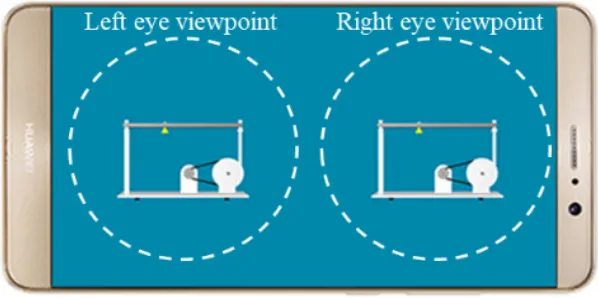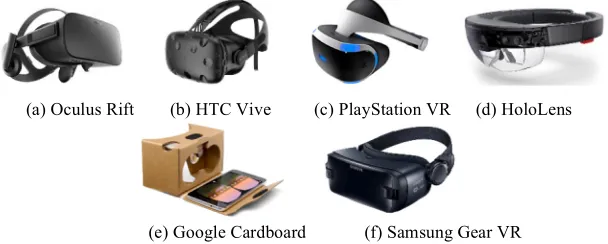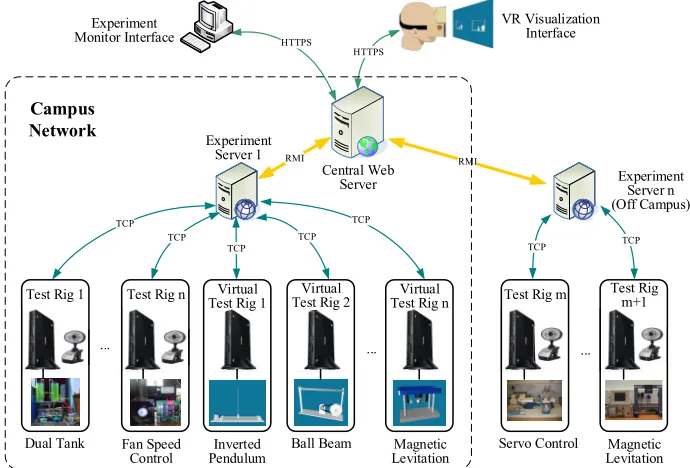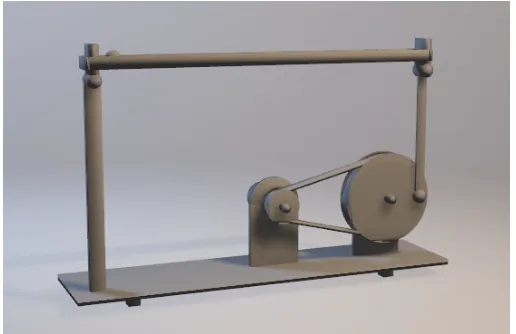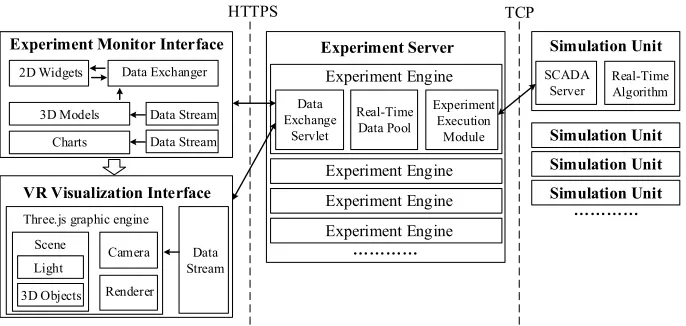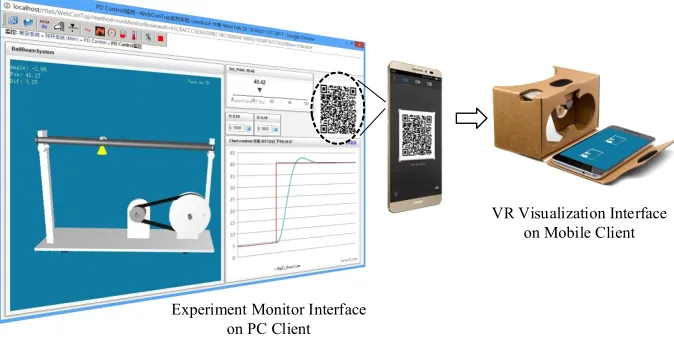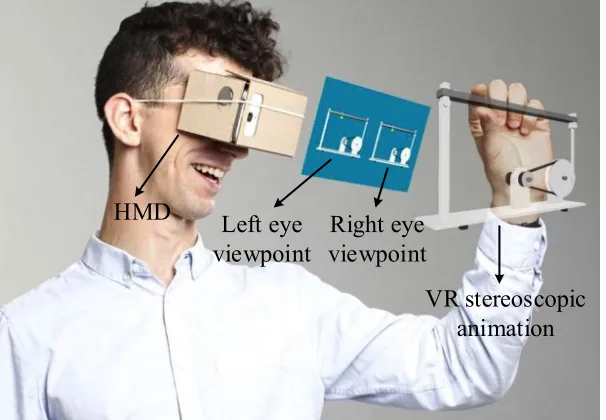VR Interactive Feature of HTML5-based WebVR
Control Laboratory by Using Head-mounted Display
https://doi.org/10.3991/ijoe.v14i03.8112
Quan Ye, Wenshan Hu!!", Hong Zhou, Zhongcheng Lei, Shiqi Guan Wuhan University, Wuhan, China
wenshan.hu@whu.edu.cn
Abstract—The development of web-based online laboratory for engineering education has made big progress in recent years with state-of-the-art technolo-gies. In order to further promote the effectiveness within an online virtual envi-ronment, the virtual reality (VR) interactive feature of WebVR Control labora-tory based on HTML5 is presented in this paper. The educational objective is to assist the students or researchers to conduct a realistic and immersive experi-ment of control engineering with a head-mounted display (HMD) equipped. The implementation of the VR technique mainly relies on the Three.js graphic engine based on Web Graphics Library (WebGL) which has been supported by most of the mainstream web browsers in their latest version without a plugin embedded. At the end of the paper, the ball and beam system is taken as an ex-ample to illustrate the whole operational approach of the VR experiment in de-tail. While such a VR interactive feature hasn’t been integrated into some of the current web-based online laboratories, the technical solution could be inspira-tional for them.
Keywords—HTML5, WebVR, virtual reality, head-mounted display, control engineering education, online laboratory
1
Introduction
As one of the well-developed hybrid laboratories, Networked Control System La-boratory (NCSLab) [8]–[13] experiences intensive development over the past decade. New features and new technologies were gradually applied into the NCSLab frame-work. More specifically, 3D animation synchronized with remote experiments was added in 2013 as illustrated in [11]. Three years later, [12] presents a HTML5 version of NCSLab which provides better user experience with fluent 3D animation in exper-imental process. And the efforts of the NCSLab team toward a powerful hybrid labor-atory to meet the engineering education’s requirements continue up to now.
In order to provide highly realistic and immersive ambience for users in virtual ex-perimental process, many hybrid laboratories have made effort in integrating various form of interactive mode based on state-of-the-art technologies and standards, one of which is the virtual reality (VR). The concept of virtual reality refers to the combina-tion of computer graphics systems with various displays and interface devices to pro-vide the effect of immersion in the interactive 3D computer-generated environment [14], [15]. Burdea Grigore and Coiffet concluded the characteristics of VR with 3I (immersion, interaction and imagination) in [16].
The VR technology has long attracted public’s attention since its advent in 1960’s, especially in the education realm. Though it is a globally focused hotspot, VR, whose wide spread dissemination is restricted by technical concerns [17], poor instructional design [18] and lack of solid hardware infrastructure, deed experienced a downturn for some time in the early 21st century. While the 2016 releases of the Oculus Rift CV1, HTC Vive, and the years earlier release of the Google Cardboard, spawned a frenzy of VR again with explosive growth of VR headset shipments.
The NMC Horizon Report, in its 2016 Higher Education Edition [19] and 2017 K-12 Edition [20], identifies VR as one of the important developments in educational technologies that are very likely to drive technology planning and decision-making over the next two or three years since the reports’ date of publication. VR boosts engagement and motivation by providing students with a strong sense of presence and immersion compared to traditional experimental environment. For instance, students have the opportunity to navigate inside the human body’s bloodstream as a red blood cell in The Body VR [21]. Educators, researchers, and design teams at North Carolina State University are using interactive 360º video capture and VR presentation to better support lab-based and field-based instruction in online learning environments [22]. [23] presents an integrated web-based learning environment of the execution of virtu-al volumetric anvirtu-alysis experiments in chemistry with the active participation for stu-dents. VR also gets an excellent performance for learning in environments that are inherently dangerous, i.e. fire-fighting or bioterrorism situations [24]. Experiences like these provide unique and fresh moments that could hold the students' attention and pique their interest in the learning process.
con-strong sense of presence and immersion, it would exercise students’ creativity and stimulate their senses in a realistic environment, which meets the objectives of Crea-tivity and Sensory Awareness.
This paper integrates the VR interactivity within NCSLab for control engineering education, whose technical solution could be inspirational for other online laborato-ries. Section II introduces the technical implementation of VR which mainly refers to adopt Three.js as the 3D graphic engine base on Web Graphics Library (WebGL). Section III gives an overall description of integrating VR within NCSLab framework as a new interactive mode. In addition, a control engineering experiment of the ball and beam system is taken as an example to illustrate the whole operational approach of the VR experiment in Section IV. At last, Section V makes a brief summary of the study.
2
VR Technical Solution
The most common choice to realize VR in web-based online laboratories has been the browser plug-in for years. As a mainstream technical solution, Virtual Reality Modeling Language (VRML) which is a standard file format, has been widely adopt-ed by online laboratories to present three-dimensional (3D) interactive vector graphics. Among the pioneer of hybrid laboratories on control engineering, the VCLab in German presented the VR realization architecture in [26] which falls back on VRML plug-in and Java Applets. The aforementioned chemical VR laboratories [23] also announced that the installation of a browser plug-in, the Cortona VRML for Parallel Graphics, is a prerequisite. The research towards a virtual radiopharmacy laboratory in Greece [27] based on the framework of VirRAD European project keeps away from VRML by using Flash Player and Shockware Player, but also failed to get rid of the dependence of browser plug-in facing the VR realization issue.
The downsides of using browser plug-in could be obviously. The application based on plug-in is often restricted to specific browser vendor, or more precisely, specific browser kernels, which naturally decrease the accessibility. In addition, the installa-tion of plug-in is unfriendly for employment, and surely bring inconvenience for tab-let/mobile users. The most important is, plug-in leads to serious security issues not only on client-side but also on server-side. Despite of the security and compatibility problems mentioned above, the developer of online laboratories have no choice but using plug-in in VR implementation in the early years.
Based on WebGL, there are many 3D graphic engines available in the market such as Unity, Unreal, Three.js and Babylon.js. The technical solution of VR in this paper mainly refers to Three.js toolkit, which is a practical 3D JavaScript library.
2.1 VR Application in 3D Graphic Engine
Three.js core library and a few key modules need to be embedded into the head of webpage at the very beginning, whose functionalities are interpreted as in Table 1.
Table 1. Functionality of integrant module
Module Name Functionality
three.js The core library for Three.js
DDSLoader.js
Loaders for processing external 3D model resources MTLLoader.js
OBJLoader.js
StereoEffect.js Split regular 3D graphics to provide the illusion of depth (an “off-axis stereoscopic effect”) for VR experience DeviceOrientationControl.js Provides the support for tracking the rotation of the VR display device
All global variables and arguments are initialized and configured in function init. In Three.js, the Scene is the most fundamental component which works like a big container to hold every other element in. Other essential components are instantiated by constructor supplied in Three.js and appended as the child objects of the Scene. For example, Camera component is instantiated to set up viewpoint for observation, while Light component is instantiated to control the illumination intensity and direc-tion in the virtual environment.
All the graphics captured by the Camera will be processed by the Renderer com-ponent, then projected to screen. In order to generate VR stereoscopic view, StereoEf-fect is instantiated by the constructor imported earlier in StereoEfStereoEf-fect.js with the Ren-derer passed as the parameter. Key codes are as follows:
effect = new THREE.StereoEffect(renderer);
Then, DeviceOrientation event listener is configured by function addEventListener to be triggered when users’ head rotates. Then by overwriting the callback function, which named setOrientationControls here, the viewpoint of virtual environment will follow users’ behaviors synchronously. Key codes are as follows:
window.addEventListener('deviceorientation', setOrien-tationControls, true);
function setDeviceOrientationControls() { controls = new
THREE.DeviceOrientationControls(camera, true); controls.connect();
Completing the basic configuration of virtual environment, it turns to load the ex-tern model resources. Using the related JS module such as DDSLoader.js, MTLLoad-er.js and OBJLoadMTLLoad-er.js, 3D models can be appended as child objects of the Scene by indicating the target file name and the path. Taking loading process of the ball and beam system as an example, the many accessories of the system such as the base, beam, axis, lever arm and ball are loaded in turn and placed at the initial position.
At the end of function init, another function named animate is called to refresh the physical state of the 3D models on each frame. And function requestAnimationFrame invokes the animate recursively. Key codes are as follows:
function animate() {
requestAnimationFrame(animate); …
camera.updateProjectionMatrix(); controls.update();
effect.render(scene, camera); }
Then, VR stereoscopic animation is rendered in the web browser supported by Three.js graphic engine. On the screen of smartphone, the frame is segmented into two parts as in Fig. 1. It seems that the left part has the quite same image with the right part. Actually, subtle distinction on the angle of view finally achieves the VR visualization effect with a head-mounted display (HMD) equipped.
Fig. 1. VR frame on the screen of smartphone
2.2 Auxiliary Equipment
High-end HMDs have comfortable user experience with independent display screen, complex device structure and advanced technology. Some even have strong computation ability with powerful sensor system as an independent professional equipment. Mobile-based HMDs have a simple structure with a bargain price. It com-pletely depends on smartphone to exhibit VR stereoscopic animation and utilizes optical structures to create depth perception.
Considering the accessibility of interest, mobile-based HMD is finally adopted by NCSLab as the auxiliary device supporting VR. Thus, users won’t need to spend on costly VR HMDs. A smartphone and a mobile-based HMD is enough for users to conduct a VR experiment.
Fig. 2. Various kinds of HMDs
3
VR Interactive Feature of NCSLab
NCSLab is a solid and mature hybrid laboratory framework in the realm of control engineering education. After over ten years’ development, it has integrated many powerful, plugin-free interactive features [13]. The VR interactive feature presented in this paper is based on the structure of original NCSLab. As shown in Fig. 3, it has a multi-tier structure which enables reliable communication channels among the web browsers, central web server, and experiment servers located dispersedly all over the world. Users can easily get the access of all the test rigs integrated in NCSLab under a universal web-based interface without considering their physical locations.
In NCSLab framework, Three.js is adopted as the 3D graphic engine to support 3D animations and VR stereoscopic animation. Based on HTML5 standard, Three.js behaves excellently in rendering interactive 3D graphic within any compatible web browser. Therefore, NCSLab could provide more fluid experience and more vivid animation at a faster speed.
(a) Oculus Rift (b) HTC Vive (c) PlayStation VR (d) HoloLens
Central Web Server Experiment
Server 1
Experiment Server n (Off Campus)
HTTPS
HTTPS
... ...
RMI
TCP TCP
TCP TCP
TCP
Dual Tank Fan Speed
Control PendulumInverted Ball Beam LevitationMagnetic Campus
Network
Servo Control Magnetic Levitation ...
Test Rig 1 Test Rig n Test Rig 1Test Rig 1Virtual Test Rig 2Virtual g Test Rig nest g Virtual Test Rig m Test Rig m+1
TCP TCP
RMI
VR Visualization Interface Experiment
Monitor Interface
Fig. 3. Architecture of NCSLab with VR interactive feature
3.1 3D Modeling
All the physical models such as test rigs and laboratory rooms of NCSLab must be modeled in 3D software first before imported into 3D graphic engine. Among the popular commercial software used for professional 3D designing, 3ds Max is adopted in NCSLab’s 3D modeling scheme. The models designed in the 3ds Max are exported into the Wavefront.obj format which can be parsed by Three.js. Fig. 4 is an example which shows the 3D model of the ball and beam system being designed in 3ds Max environment.
Fig. 4. Model of the ball and beam system designed in 3ds Max
3.2 Data Communication
After years of debugging and modification, a mature data communication scheme among the user interface, experiment server and remote controllers finally become as shown in Fig. 5.
On the server-side, there are many Experiment Engines deployed in the Experi-ment Server. Each one corresponds to a test rig separately. In the ExperiExperi-ment Engine, three major function modules play a key role in the communication channel, which named Data Exchange Servlet, Real-Time Data Pool and Experiment Execution Module respectively. When a control algorithm is downloaded and executed in the Simulation Unit, a Transfer Control Protocol (TCP) communication is established automatically between the Experiment Execution Module and the Supervisory Con-trol and Data Acquisition (SCADA) Server running in the Simulation Unit. The status data is captured persistently from the Simulation Unit and transmitted to the Experi-ment Execution Module through the TCP communication, further temporarily stored in Real-Time Data Pool.
SCADA Server Simulation Unit Data Exchange Servlet Real-Time Data Pool Experiment Engine Experiment Server Experiment Execution Module 2D Widgets Data Exchanger
Experiment Monitor Interface
Data Stream 3D Models
Charts Data Stream
VR Visualization Interface
Data Stream Three.js graphic engine
Camera Scene
Light
3D Objects Renderer
HTTPS TCP Experiment Engine Experiment Engine Experiment Engine Simulation Unit Simulation Unit Simulation Unit Real-Time Algorithm
Fig. 5. Data communication schemes for VR interactivity
3.3 VR Visualization Interface
Three.js provides plenty of alternative JavaScript resources for customizing 3D an-imations as users’ will. Among them, StereoEffect.js and DeviceOrientationCon-trols.js are the foremost object which need to be embedded in the head of the webpage. More specifically, StereoEffect.js works as the most fundamental compo-nent supporting the render of VR stereoscopic animation while Device Orientation-Control.js captures the rotation of VR display device.
All the latest status data of experimental process transmitted from Data Exchange Servlet are cached by the Data Stream object. Then, in the callback function animate, the data is extracted by the Three.js graphic engine and utilized for the modification of 3D models’ positions and angles.
As a result, the VR stereoscopic animation keeps good consistency with remote experimental process by updating status data from datalinks. That means both of the native 3D animation and VR stereoscopic animation, one on PC desktop browser while the other on mobile browser, are synchronized with the real experiment process.
4
A Case Study
NCSLab has been applied in the undergraduate teaching system for years. It serves for several experimental curriculums in the field of control engineering education. According to a questionnaire implemented by the website builder, NCSLab actually plays an active role in helping students understand the course content and improve laboratory skills [13].
the opinion, the ball and beam system is taken as an example to make out how to conduct a VR experiment.
Several jobs need to be managed first. Students or researchers should customize their own control algorithms based on the feature analysis of the target control sys-tem. In terms of the ball and beam system, both PD control and LQR control are proper algorithms used for making the system stable. This step need to be accom-plished by Matlab Real-Time Workshop (RTW) module in the Matlab Server envi-ronment. Actually, there already have some classical control algorithms with simple construction available in the NCSLab for quick experience. After compiling the algo-rithm into executable program, users should upload it to the NCSLab server database through the web interface. And the executable programs will be downloaded to the Simulation Unit automatically. After that, a new window pops up for the flexible configuration of Experiment Monitor Interface. There are many kinds of 2D and 3D widgets optional for users such as dynamical charts, sliders, virtual gauges, numeric inputs.
Experiment Monitor Interface on PC Client
VR Visualization Interface on Mobile Client
Fig. 6. Get the access of VR Visualization Interface by scanning QR code
While the preparatory work completed, online experiment is ready for launching. As in Fig. 6, by scanning the dynamic generated QR code on the top right of the Ex-periment Monitor Interface, users could get the only access of VR Visualization Inter-face. Through extracting the latest status data from the datalinks, the position of the ball and the angle of the beam in VR stereoscopic animation are synchronized with the remote experimental process as well as the 3D animations in Experiment Monitor Interface.
anima-students also have access to transform the viewpoint by rotating their heads, which will be tracked by the gyroscope sensor of smartphone and further captured by the Three.js graphic engine.
With this new interactive feature applied in the control engineering education, stu-dents are expected to achieve the following learning outcomes:
1.The ability to conduct a hands-on experiment in the real world independently; 2.The grasp of the basic working theory of test rigs;
3.Accurate comprehension of control parameters for automatic control system; 4.The ability to assemble appropriate control parameters to make control system
sta-ble or meet other specific needs;
5.The ability to identify the origin of the abnormal outcome of the control system and then re-engineer effective solutions.
Left eye
viewpoint
viewpoint
Right eye
VR stereoscopic
animation
HMD
Fig. 7. Experience the VR experiment
5
Conclusion
example to demonstrate the process of conducting a VR experiment. With HMD equipped, students or researchers could get an authentic and immersive VR experi-ence which beyond the traditional online laboratories’ comparison. The new VR in-teractive feature of NCSLab could lead to the increase of students’ engagement and motivation with a strong sense of presence and immersion and provide an arena for visualizing abstract concepts concretely, and the plugin-free technical solution could be inspirational for other web-based online laboratories to integrate such a new inter-active feature.
6
Acknowledgment
This research is supported by National Natural Science Foundation (NNSF) of China under Grant 61374064.
7
References
[1]R. Heradio, L. De Torre, and S. Dormido, “Virtual and remote labs in control education: A survey,” Annu. Rev. Control, vol. 42, pp. 1–10, 2016. https://doi.org/10.1016/j.arcontrol. 2016.08.001
[2]V. Potkonjak et al., “Virtual laboratories for education in science, technology, and engineering: A review,” Comput. Educ., vol. 95, pp. 309–327, 2016. https://doi.org/10.1016/j.compedu.2016.02.002
[3]L. Gomes and S. Bogosyan, “Current Trends in Remote Laboratories,” IEEE Trans. Ind. Electron., vol. 56, no. 12, pp. 4744–4756, Dec. 2009. https://doi.org/10.1109/ TIE.2009.2033293
[4]C. Gravier, J. Fayolle, B. Bayard, M. Ates, and J. Lardon, “State of the art about remote laboratories paradigms-foundations of ongoing mutations,” Int. J. Online Eng., vol. 4, no. 1, pp. 19–25, 2008.
[5]Z. C. Zacharia, “Comparing and combining real and virtual experimentation: an effort to enhance students’ conceptual understanding of electric circuits,” J. Comput. Assist. Learn., vol. 23, no. 2, pp. 120–132, Jan. 2007. https://doi.org/10.1111/j.1365-2729.2006.00215.x
[6]T. de Jong, M. C. Linn, and Z. C. Zacharia, “Physical and Virtual Laboratories in Science and Engineering Education,” Science (80-. )., vol. 340, no. 6130, pp. 305–308, Apr. 2013. [7]J. R. Brinson, “Learning outcome achievement in non-traditional (virtual and remote)
versus traditional (hands-on) laboratories: A review of the empirical research,” Comput. Educ., vol. 87, pp. 218–237, Sep. 2015. https://doi.org/10.1016/j.compedu.2015.07.003
[8]W. Hu, G. P. Liu, D. Rees, and Y. Qiao, “Design and implementation of web-based control laboratory for test rigs in geographically diverse locations,” IEEE Trans. Ind. Electron., vol. 55, no. 6, pp. 2343–2354, 2008. https://doi.org/10.1109/TIE.2008.920646
[9]Y. Qiao, G. P. Liu, G. Zheng, and W. Hu, “NCSLab: A web-based global-scale control laboratory with rich interactive features,” IEEE Trans. Ind. Electron., vol. 57, no. 10, pp. 3253–3265, 2010. https://doi.org/10.1109/TIE.2009.2027924
[10]W. Hu, G. P. Liu, and H. Zhou, “Web-based 3-D control laboratory for remote real-time experimentation,” IEEE Trans. Ind. Electron., vol. 60, no. 10, pp. 4673–4682, 2013.
[11]W. Hu, H. Zhou, Z. W. Liu, and L. Zhong, “Web-based 3D interactive virtual control laboratory based on NCSLab framework,” Int. J. Online Eng., vol. 10, no. 6, pp. 10–18, 2014. https://doi.org/10.3991/ijoe.v10i6.3845
[12]Z. Lei, W. Hu, and H. Zhou, “Deployment of a Web-based Control Laboratory Using HTML5,” Int. J. Online Eng., vol. 12, no. 7, pp. 18–23, 2016. https://doi.org/10.3991/ ijoe.v12i07.5819
[13]W. Hu et al., “Plug-in free web-based 3-D interactive laboratory for control engineering education,” IEEE Trans. Ind. Electron., vol. 64, no. 5, pp. 3808–3818, 2017. https://doi.org/10.1109/TIE.2016.2645141
[14]Z. Pan, A. D. Cheok, H. Yang, J. Zhu, and J. Shi, “Virtual reality and mixed reality for virtual learning environments,” Comput. Graph., vol. 30, no. 1, pp. 20–28, 2006.
https://doi.org/10.1016/j.cag.2005.10.004
[15]B. Dalgarno and M. J. W. Lee, “What are the learning affordances of 3-D virtual environments?,” Br. J. Educ. Technol., vol. 41, no. 1, pp. 10–32, 2010. https://doi.org/10.1111/j.1467-8535.2009.01038.x
[16]G. Burdea and P. Coiffete, Virtual Reality Technology. John Wiley & Sons, 2003.
[17]Z. Merchant, E. T. Goetz, L. Cifuentes, W. Keeney-Kennicutt, and T. J. Davis, “Effectiveness of virtual reality-based instruction on students’ learning outcomes in K-12 and higher education: A meta-analysis,” Comput. Educ., vol. 70, pp. 29–40, 2014.
https://doi.org/10.1016/j.compedu.2013.07.033
[18]C. J. Chen, S. C. Toh, and W. M. F. W. Ismail, “Are Learning Styles Relevant To Virtual Reality?,” J. Res. Technol. Educ., vol. 38, no. 2, pp. 123–141, Dec. 2005.
https://doi.org/10.1080/15391523.2005.10782453
[19]L. Johnson, S. Adams Becker, M. Cummins, A. Freeman, and C. Hall, “NMC horizon report: 2016 higher education edition,” Austin, Texas: The New Media Consortium, 2016. [20]A. Freeman, S. Adams Becker, M. Cummins, A. Davis, and C. Hall Giesinger,
“NMC/CoSN Horizon Report: 2017 K–12 Edition,” Austin, Texas: The New Media Consortium, 2017.
[21]“The Body VR.” [Online]. Available: http://thebodyvr.com/.
[22]“360o Video, Virtual Reality Presentation Highlights Edu Applications.” [Online]. Available: https://delta.ncsu.edu/news/2015/12/01/360o-video-virtual-reality-presentation-highlights-edu-applications/.
[23]J. Georgiou, K. Dimitropoulos, and a. Manitsaris, “A virtual reality laboratory for distance education in chemistry,” World Acad. Sci. Eng. Technol., vol. 1, no. 11, pp. 345–352, 2007.
[24]J. N. Bailenson, N. Yee, J. Blascovich, A. C. Beall, N. Lundblad, and M. Jin, “The Use of Immersive Virtual Reality in the Learning Sciences: Digital Transformations of Teachers, Students, and Social Context,” J. Learn. Sci., vol. 17, no. 1, pp. 102–141, Feb. 2008.
https://doi.org/10.1080/10508400701793141
[25]L. D. Feisel and A. J. Rosa, “The Role of the Laboratory in Undergraduate Engineering Education,” J. Eng. Educ., vol. 94, no. 1, pp. 121–130, Jan. 2005. https://doi.org/10.1002/ j.2168-9830.2005.tb00833.x
[26]C. Schmid, “Virtual control laboratories and remote experimentation in control engineering,” in Proc. 11th EAEEIE Annual Conference on Innovations in Education for Electrical and Information Engineering, University of Ulm, Ulm, 2000, pp. 213–218. [27]A. Alexiou, C. Bouras, E. Giannaka, V. Kapoulas, M. Nani, and T. Tsiatsos, “Using VR
8
Authors
Quan Ye received the B.S. degree in automation from Wuhan University, Wuhan, China, in 2011, where he is now working towards the M.Sc. degree in the Department of Automation. His current research interests include networked control systems and web-based remote laboratories.
Wenshan Hu received the B.S. and M.Sc. degrees in control theory and applica-tions from Wuhan University, Wuhan, China, in 2002 and 2004, respectively, and the Ph.D. degree in control engineering from the University of Glamorgan, Pontypridd, U.K. in 2008. In June 2010, he joined Wuhan University as an Associate Professor. He has been a professor since 2016. His research interests include network-based control laboratories and wireless power transfer. (e-mail: wenshan.hu@whu.edu.cn)
Hong Zhou received the B.S. degree in automation from the Central South Uni-versity of Technology, Changsha, China, in 1982, the M.Sc. degree in control theory and applications from Chongqing University, Chongqing, China, in 1988, and the Ph.D. degree in mechanical engineering from Wuhan University, Wuhan, China, in 2006. He has been a professor in the Department of Automation, Wuhan University, since 2000. His research interests include wireless power transfer, smart grid, and networked control systems.
Zhongcheng Lei received the B.S. degree in automation from Wuhan University, Wuhan, China, in 2014, where he is currently working toward the Ph.D. degree in the Department of Automation. His current research interests include networked control systems and web-based remote laboratories.
Shiqi Guan received the B.S. degree in automation from Wuhan University of Technology, Wuhan, China, in 2012. She is now working towards the M.Sc. degree in Department of Automation, Wuhan University. Her current research interests include networked control systems and web-based remote laboratories.

